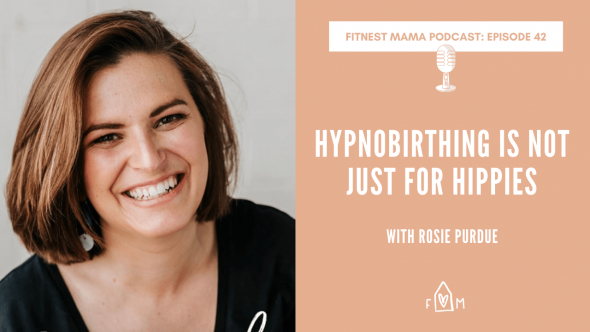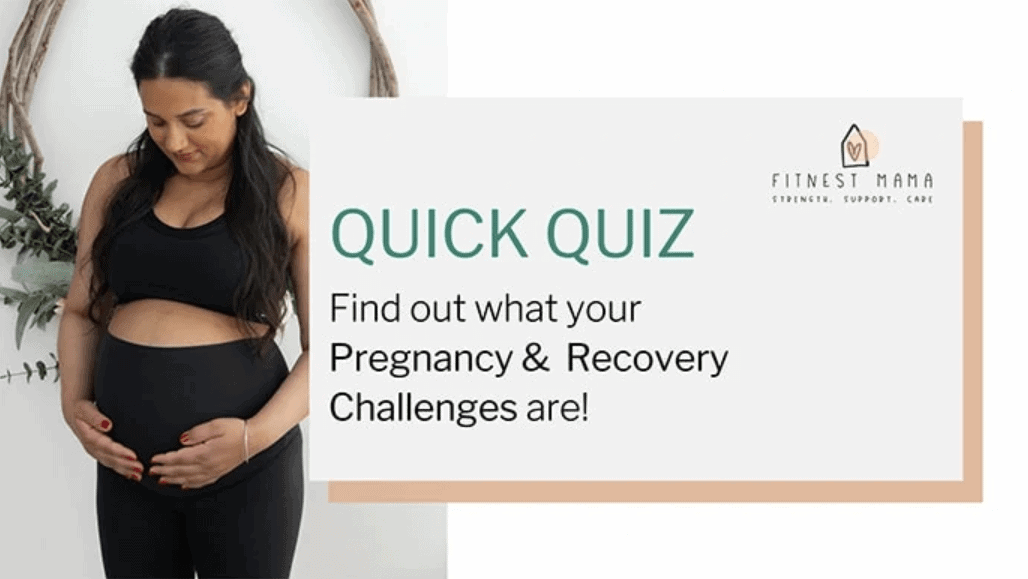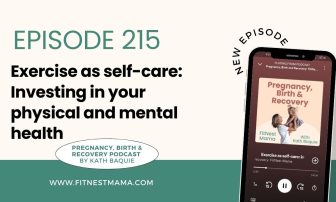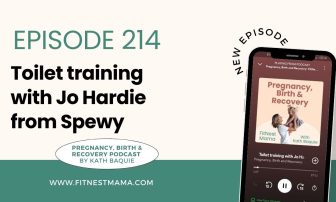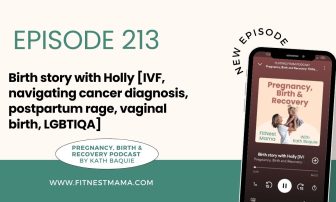Well, hi there. Welcome to Episode 42, the FitNest Mama Podcast. Today I’m excited to be joined by the lovely Rosie Perdue, who is a fellow pelvic floor physio, but she’s also a hypnobirthing consultant. So in today’s episode with Rosie I quiz her about a what is hypnobirthing, and why is it called hypnobirthing? What are the benefits of hypnobirthing? What are her top tips for using hypnobirthing in childbirth? And we discuss how these techniques can be useful for childbirth no matter how you birth, but also how it can hold lifelong benefits and skills as a mother. So do stick around.
Before I jump into this episode, I want to let you know about an exciting free 3-Day Postnatal Workshop which is really coming up soon on Monday July the 19th. This workshop it’s called, “Getting Back into Fitness”. It’s for you if you’ve had a baby, if you’re keen to get back into fitness, whether or not that’s walking, running, CrossFit gym or tennis. So in these 3 days you will learn if your body is ready to get back into fitness. You will learn if your body is ready to take it to the next stage of postnatal rehab. By the end of these 3 days you will understand more confidently if your pelvic floor muscles are ready for high impact exercise. You will learn what general body stability tests are important to do before you hit the payments and get back running. And you’ll get access to a quality workout focus on pelvic floor and core with an introduction to high impact exercises. So this is all from the comfort of your home. By the end of these 3 days you will feel confident and empowered to take your postnatal rehab up to the next level. Just head to https://fitnestmama.com/postnatalworkshop. And the link is in the show notes.
Alright! Let’s get into this episode. Hello, Rosie, thank you for joining me today. Brilliant. So could you please introduce yourself for everyone listening today?
ROSIE PERDUE
Sure. So like you I am a physio and I primarily work with in women’s health and I have a special interest in in pre and postnatal health. And I am also a hypnobirthing Australia practitioner, hence chatting about that today. So I was working with a lot of pain postnatal women. And obviously, as part of our job, we include a lot of childbirth education anyway. And so then I had actually done this course as a participant when I had my daughter. And I really enjoyed the course. And so then I looked into being an instructor or a facilitator of the course. Second, I did the training to be a practitioner. And so now I run generally monthly courses on childbirth education through that Hypnobirthing Australian Program.
KATH BAQUIE
It’s such a unique set of skills you have. It’s lovely. How long ago did you first do the hypnobirthing course?
ROSIE PERDUE
I did it two years ago.
KATH BAQUIE
Yeah. And how did you find it impacted or helped your childbirth experience?
ROSIE PERDUE
A lot of the actual training in the course was in detail, we do a few subjects that they do in their midwifery degree. Which is amazing, because a lot of that, I don’t know. So we obviously can see people immediately on postnatal ward. And we can understand our experience if we’ve had a child of what our birthing experience was, but a lot of the ins and outs of what’s actually happening in labour that I didn’t know before doing the training for the course. And then a lot of that training for the course is not actually included in the delivery of what we actually teach people. But that certainly made me a better teacher and a better practitioner because that stuff is not just common knowledge and if people mentioned something to me now as either as a physio or running the course, I have a much better understanding certainly not as good as the midwives by no means. Got a much better understanding of what is happening during the birthing process?
KATH BAQUIE
Yeah, that’s brilliant. So what do you see are the key benefits of hypnobirthing?
ROSIE PERDUE
This particular course, the main benefit is that we don’t hop on about, this is the kind of birth that you should have, we really emphasize that we’re going to give you a lot of the science as to the way your body might work at its best. But then if other things come up, then medical intervention, then aren’t we lucky that we’re in a society where that’s offered to us? So if you’ve already got all the tools to understand why these things might be happening, or what’s the risks of something, what’s the benefit of something, then you’re included in that decision making process. And therefore, regardless of what’s happening during your birth, if you come out and you feel like you’re a part of it, and it was a good experience, then whether you end up with a vaginal delivery, or intervention, or we’ll use medication or don’t use medication or have a severe infection, either by choice or in an emergency situation where you’re included in the choice, and then you come out feeling good.
So that’s why I like this course, we definitely don’t talk about this is the sort of birth that you should have.
KATH BAQUIE
Yeah. And that’s so important, isn’t it? Because, you know, you might want one sort of birth. But if it doesn’t happen, like I hear so many women who are really upset that birth perhaps didn’t transpire the way that they’d hoped for. And so that’s brilliant that that’s, you know, what you’re teaching and what you’re doing with these courses.
ROSIE PERDUE
Yeah. And they make it quite clear with the courses broken down into four parts. So definitely run over a weekend. So let’s say Saturday morning, we go into a little bit of the science. So this is the stuff that for you and I, we already know about the flight and fight response and about how oxygen is needed to make your muscles work. But for a lot of parents and birthing people, that’s not necessarily something that they understand. So we do a lot of heavy science stuff in the morning.
And then in the afternoon, on the first day, we run through the really dorky analogy of a toolkit. So what are all the things that you could do, you could use, and they’re the things that people would generally think about when deciding whether they would do something like hypnobirthing.
And that’s those techniques we talked about, like breathing and massage and then Sunday morning is very information heavy about your choices. So what is an episiotomy? What is morphine, all the different choices? And then in the afternoon, we do a little bit more practical things like birthing positions, when would you go to the hospital, and the afternoon these days is a lot more valid, because a lot of parents are not doing their hospital courses. And a lot of the hospital courses aren’t even running. So things like, when do you call the hospital? You know, how do I know I’m in labour? Those kind of practicality things we cover in the afternoon.
KATH BAQUIE
So it sounds like it’s about 50% sort of theory and learning stuff. And then 50% getting things into action and practicing stuff. Is that right? Roughly?
ROSIE PERDUE
Yeah. And then a lot of people do the course at around 30 weeks pregnant. So then they’ve got a bit of time to actually practice things before they go into labour. Because as you know, if you’ve practiced things before, they’re top of mind, you’re more likely to do them, they’re more comfortable. It’s not something that you have to learn while you don’t actually want to be learning anything. You just want to do it.
KATH BAQUIE
So tell me about the name hypnobirthing, because where does the “hypno”, like when I think of “hypno”, I think of being hypnotized. Like, where does the word “hypno” come into it.
ROSIE PERDUE
So to be honest, I think it detracts a little the actual branding tracks a little bit from the course because in no way are you going to be you’re going to be hypnotized.
KATH BAQUIE
Yeah.
ROSIE PERDUE
You do walk about being in a state of self-hypnosis. But that is basically just being in a deep state of relaxation. So we know that we go in and out of different states of consciousness throughout our entire day. And so if you can learn or condition yourself to be in as best physical state of relaxation as you can at the time, when that’s going to work best for you. That’s where the “hypno” part comes in. So trying to tap into the subconscious and the things in our subconscious to bring them more into our consciousness.
KATH BAQUIE
I’m really glad you brought that up. Because to be totally honest, eight years ago, when I was investigating all of these, that term hypnobirthing, put me off it.
ROSIE PERDUE
Yeah. It’s sounds a little bit voodoo or hippie and it’s not.
KATH BAQUIE
I know and since then obviously lead to a lot more and having had three childbirth experiences, and I just think it’s amazing, but it was good to find out your thoughts on that term. He made a rebrand, I don’t know.
Now what you mentioned before being a pelvic floor physio, so we’re talking about we call physio to pelvic floor physio here, I’ll be really interesting to hear your thoughts. Because I really do feel one of the biggest benefits of well, there are many benefits, but one of them is being in that state of relaxation, as you describe really can help with that pelvic floor relaxation during childbirth. And to put it really simplistically, it’s uterus’ job to push out the baby. And it’s a pelvic floor’s job to relax and get out of the way. From a pelvic floor point of view, how do you find hypnobirthing helps?
ROSIE PERDUE
I probably throw my two cents in the course a little bit. We’re not meant to change the structure of the course. But we do talk about pelvic floor care in the course. And then I just talked about a little bit more because I’ve got the expertise too and so we even do scripts about and when I say scripts, it’s literally me reading out how to relax your face and how to relax your jaw and how to then follow down that relaxation down to relax your pelvis and your pelvic floor. So we touched on it in the course for sure about how to if you are in a state of relaxation, then your muscles will work more optimally. And in the course. Because not everyone would have that pelvic floor background like you and I, it’s probably more skewed towards when you’re in a deep state of relaxation, your uterus is working better. Rather than focusing on when you’re in a deep state of relaxation, your pelvic floor is working better.
So we mentioned that briefly. Because as you said, when your pelvic floor needs to relax and open to allow the baby to birth. And we do talk about that in the course but not a huge amount. But we do mention it in terms of what we’re talking about relaxation of the muscles working at their best in the course we focus more on the uterus. So we’re talking about if you’re in that away from that fight or flight response, then more oxygenated blood will go to your uterus.
So for those who are listening, that don’t understand that flight or fight response, you know, you think of the tiger running at you, your defence systems up, you’re ready to run away from the tiger. So your oxygenated blood and your energy is going to the muscles that will help you survive in that situation. And your uterus is not part of the defence system. So that oxygenated blood will be directed away from the uterus to say your arms and legs to run away and fight. And therefore you’re directing the oxygenated blood away from the uterus, which is the muscle and it’s the only muscle at the time that needs to be working at its best. So when you’re relaxed, you’re getting more blood flow to the uterus, and therefore the uterus muscle works better.
So rather than defining relax uterus, we talked about relaxing the body and in turn having the uterus work better. And then when the uterus is working better, and the pelvic floor is nice and relaxed, because your body in general is relaxed. Then the baby comes out easier.
KATH BAQUIE
Yeah. Brilliant and as speaking to I think it was Loretta from calm birth. Ballarat. She talked like you mentioned the tiger, was that the tiger you mentioned? Yeah, she mentioned a cat or a dog. If you can imagine if a cat or dog’s going to give birth, they’re not going to give birth in the middle of the kitchen where there’s noise and light and always distractions, they will take themselves into the darkest, quietest area of the house and covered, not that I’ve ever had cats or dogs give birth in my house, but I believe that’s where they give birth where they’re feeling more relaxed and safer and calm.
ROSIE PERDUE
Yeah. We use that analogy in the course as well that we link that to the different parts of the brain that you want to be using. And utilizing optimally when you’re giving birth so our brains can’t work at 100% capacity everywhere in the brain all the time. And because we have different areas of the brain that are stimulated by different parts, the neocortex. So the part of the brain that is really stimulated by analysis being asked questions, bright lights, that’s amazing in a work sets, and then there’s the deep, deep part of the brain, that reptilian part of the brain, that is, it’s just responsive, it’s reflexive, it is responsible for giving birth, that if you’re in the bright lights, and you’re being asked questions, and you’ve got, you have to think about things and you’ve got direct eye contact, then that part of the brain will be taking away some of the direction from that reptilian part of the brain.
So if we can avoid as much as we can, the bright lights and the stimulation and being asked tricky questions and having to analyse things, then you’re going to use that other part of your brain better. And that’s why we know that mammals, except for us, avoid bright lights, as well. And so that’s where then we put that into practicality that a lot of the birthing people who do the course have chosen to birth at a hospital rather than at home, but you can still make your hospital environment as nurturing as you want to.
So you don’t have to have the lights on when you walk into the birth suite, once you’re in the birth suite, the partner, or your support person can just turn the lights off. So therefore, we’re reducing some of that input that is going to the brain that we don’t want to use, in which case utilizes that other part better that we do want to use.
KATH BAQUIE
Amazing. And so what are some other tips around sort of creating that environment?
ROSIE PERDUE
We know that people labour better at home where they’re feeling safe and nurtured. So some of the environmental tips that we do apart from turning off the light, bringing some familiar things, so you might bring in your own pillow, or you might bring in a blanket, you can’t burn candles in the hospitals, but you can bring in a diffuser. So creating a scent that reminds you of being at home, you might put photos up on your wall in your actual room of your family or of your house or even if your ultrasound so something that then brings on those hormones that make you feel safe and nurtured.
So you can set up the environment in lots of ways. And we try and use all your different senses as well. So, sound, you can bring in a playlist. And when I say playlist, it doesn’t have to be beautifully calming. At some point, you may want to be really calm and you might want to listen to Bob Marley, Angus and Julia Stone, or something that is a little bit more soothing, but at some point, you might want to be more active, but you can still set the scene in your room that is still homely and nurturing. So you might then want to play whatever other music you like. Salsa music to get you wiggling your pelvis around. And then you’re not having that hospital room. Same like a hospital room, you can set it up as much as you want to be like home.
So sense sound, sight, dimming the lights, not having people coming and going. Only knowing the people who are in your room. If you’re birthing in a public hospital and you have a student come in, fine, allow the student to come in if you want them to. But introduce yourselves so that you know. Okay, that’s who’s here in my presence in my space. And it’s not just like you have someone they’re looking at you birthing. So just kind of trying to create an environment that mimics where you feel safe and nurtured even just in terms of the clothes that you wear. So if you want to wear clothes, when you’re birthing, you don’t have to, you can be nude if you want to. But if you want to, maybe don’t wear a shirt that you’ve never worn before, wear a shirt that you’ve worn on a holiday to bed, and therefore you can try and recreate some of that atmosphere that is not a hospital atmosphere.
KATH BAQUIE
Oh, I like that tip. That’s a bit different to normal. That’s great.
ROSIE PERDUE
Anything that is comforting and soothing. Even the food like bring in your own snacks and bring in a snack that is not brought from the vending machine downstairs.
KATH BAQUIE
That’s brilliant.
Okay, so you mentioned that if you are going to do a hypnobirthing course from 30 weeks is great, but I know a hypnobirthing course is a whole weekend and you come along lots and lots and we will not be covering all that today. But could you give your top few tips for how like around using hypnobirthing principles for childbirth? So you’ve mentioned a couple there. So in terms of creating the environment, and changing the environment, so I guess that’s one massive tip, do you have any others?
ROSIE PERDUE
One tip, we talk about different reading techniques in the course. And I feel like some tips that we give take with a grain of salt, like some tips some people aren’t really into, and that’s fine, but it’s there, because someone else might really use it. But I feel like different breathing techniques is something that almost everybody uses. And we break up the breathing into three different breathing patterns. So we talk about relaxation, breathing, and we talk about the breathing that you might have during a surge. And when I say surge, I actually use the term contraction, but because to me, a contraction is a muscle being used. And that’s a good thing. But we’re very aware of language in the course that some people might find the term contraction, a little bit confronting, so we then might call it a surge.
So we do relaxation, breathing, surge breathing, and then we talk about the breathing that you’ll use when you’re pushing or you’re bearing down. But we don’t teach that because that’s very instinctive. So the relaxation, breathing is the thing that most people, I would say, almost everybody does after they’ve done the course. And it’s really simple. And it’s something that you and I would teach, often with our clients who have chronic pain, and it is diaphragmatic breathing, and only as little as three diaphragmatic breaths through the nose taps into the parasympathetic system, and reduces some of the pressure in that intra-abdominal cavity. So we want low pressure to be able to get the baby out. And we want to try and stay as calm as we can. So as little as three diaphragmatic breaths through the nose is actually tapping into exactly what we want to.
So what we do is that, let’s say you have a contraction for a minute, or everything tightens for a minute. After that minute, we want you to come back down to what if as quickly as possible, being a super relaxed as possible. So we teach to put the hand on the belly, breathe in through the nose, and fill the belly, right out through the nose and go floppy, right in through the nose and feel the belly. Not through the nose, and into the nose, and out through the nose. And as simple as that can make you feel a little bit calmer, and reduce that pressure in that intra-abdominal cavity. So really easy. Once you’ve done it a little bit of like once practice that available all the time, no matter where you are, you know, if you’re in the car on the way to the hospital, and free, you don’t have to rely on anyone else. And it’s a really nice prompt for the birth partner. So if the mum does look like she’s feeling a little bit overwhelmed, the birth partner, all they have to do is just change their tone of voice and say breathe in through your nose, feel your belly, and therefore they cap in straightaway. Oh, yeah, I’ve done it. Before I know how to do that. That’s easy.
KATH BAQUIE
And I’ll just add here, this is easy, right? We’re just breathing. But having said that, when you’re in the moment and you’re in the thick of it, it can be harder to bring on those instinctive exactly what we’re talking about. So if we’ve practiced this beforehand, then I really do feel it’s easy to call upon when we’re in the moment.
ROSIE PERDUE
Yeah. And that kind of technique as well. Like, you don’t just have to use that for birth that can be in you know, if you’re in my class where like, if you’re driving and stuff in the traffic, you can just do three breaths. And if you know how to do it, and you’ve done it before, you can just use that technique in life. It doesn’t necessarily then have to relate it to your birthing experience as well.
KATH BAQUIE
100% and you can do this with an epidural or you can do this during a caesarean birth. You can do this when your toddler is having a tantrum and or when your baby’s been screaming for hours and you just feel you need to calm everything down a little bit. So absolutely. It’s a lifelong skill.
ROSIE PERDUE
Yeah and if you understand the science behind it, you’re then also a little bit more likely to actually do it.
KATH BAQUIE
Yep. Great. So that was your relaxation, breathing.
ROSIE PERDUE
Yeah, so probably my three main things, I’d be setting up the environment in the room. I think that’s one of the most important thing we get out of the course. I think breathing techniques I think is one of the most important things we get out of the course. And then the other one we get out of the course is how the birth support person can be the advocate for the mother. And we use this analogy called the brain analogy, given choices presented. So let’s say the choice is your 42 weeks, and the medical care givers suggesting an induction. So if the partner then can use this “BRAIN” analogy, so “B” is for benefit. So what’s the benefit of doing an induction? “R” is the risks. So what are the risks of doing that? “I” is, what’s my intuition? What’s my gut telling me? I missed a bit? And then “N”, what if I doing nothing? What if we just wait, wait this out as well? I’m going to check what this, I’m trying to think what is the end? I definitely know that it definitely should feel like I know that.
It’ll come to me anyway. But running through your head? What if we do this? What have we done? What are the good things? What are the bad things? What’s my gut telling me to do? And so then, that birth support person is just feeling a little bit more confident themselves in being an advocate for the birthing person, or in a lot of cases, the mother.
KATH BAQUIE
Going through those brain, what do we call it? Analogy? no, not analogy. We’re both having or having word blanks, we’re both feeling a bit tired today. But going through that, that’s perfect for any intervention, like your whole life long if you ever have to have surgery, or, you know, any major medical decision in the future, you can go through that same, you know, situation, benefits risks. Intuition, what happens if you do nothing at all?
ROSIE PERDUE
Yeah, and sometimes those decisions have to be made really, really quickly in a birthing setting, because it is a medical emergency. So sometimes they won’t have the time to go through all of them in their mind. But if you’ve already been shown a lot of respect by your caregivers, then you’ve already developed a little bit of a better relationship anyway. So there’s going to be mutual trust, because the caregivers have already realized we are quite educated in this setting, I’m always going to consult you about these decisions, and you then have respect for them as well. So if it is a real emergency situation, and you don’t have time to run through all those things, the caregiver is more likely to have trust in the health professional to make that quick decision on the spot as a joint decision as well.
KATH BAQUIE
Brilliant. Thank you, Rosie. I think you’ve just, in a very short period of time, given some really practical, great tips that even if you’re not going to do a hypnobirthing course, they might be really useful. But if someone does want to find where you are, and find out more about you, how can everyone find you?
ROSIE PERDUE
So if they want to just do it, the Hypnobirthing Australia Course in general, they just go to https://hypnobirthingaustralia.com.au/, and then they put in their postcode. And it’ll bring up all the practitioners who are trained to take it that live near you. And then everyone has their own website. So then you can just click on their website, if they’re nearby, read up on their bio. We obviously all have different personalities and different skills. So some people might sit well in their bio compared to others. That’s the best way to find who’s local to you. And then if anyone specifically is trying to look to do course with me, they just go to www.healthypregnancy.com.au. It’s pretty easy to remember.
KATH BAQUIE
Brilliant. Thank you so much, Rosie, for all your words of wisdom today and your insights into hypnobirthing.
ROSIE PERDUE
You’re welcome, Kath.
KATH BAQUIE
We’ll chat soon. Thank you.
ROSIE PERDUE
You’re welcome. Bye.
KATH BAQUIE
And before I sign off, remember my team and I will be putting together the Show Notes for this episode with all the links at https://fitnestmama.com/podcast, including how to join our free 3-Day Postnatal Workshop: Getting Back into Fitness. Lastly, if you enjoyed this episode, to be able to leave a rating and review would mean the world to me. Not only does it make my day, but it also really helps this podcast get discovered by other pregnant and new mums who might really benefit from listening to a few of these podcast episodes. Have a fabulous day everyone and I look forward to you joining me next week for another episode of the FitNest Mama Podcast.
Thanks for listening to the FitNest Mama Podcast brought to you by the FitNest Mama Freebies found at www.fitnestmama.com/free. So please take a few seconds to leave a review, subscribe so you don’t miss an episode. And be sure to take a screenshot of this podcast uploaded to your social media and tag me, @fitnestmama, so I can give you a shout out too. Until next time remember, an active pregnancy, confident childbirth, and strong postnatal recovery is something that you deserve. Remember, our disclaimer, materials and contents in this podcast are intended as general information only and shouldn’t substitute any medical advice, diagnosis or treatment. I’ll see you soon.
